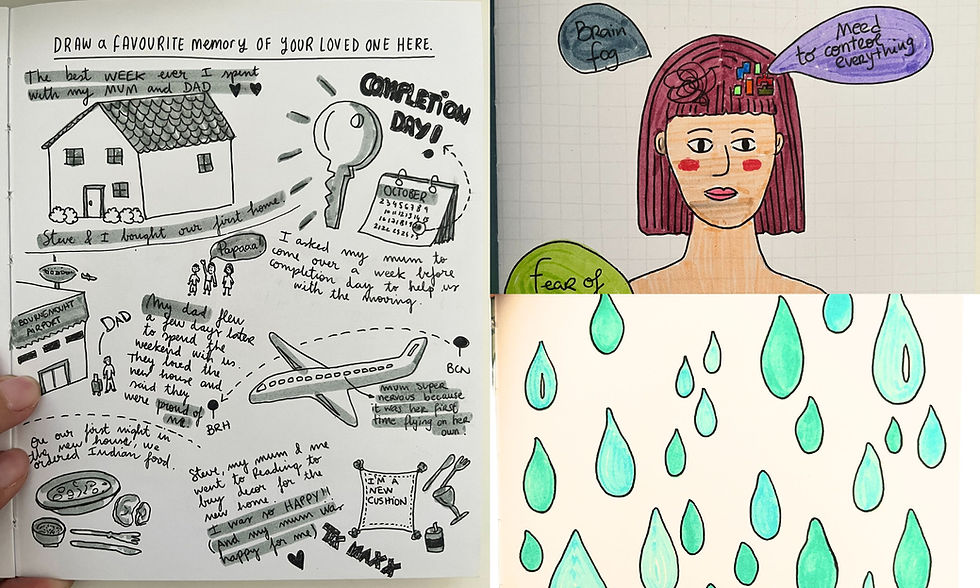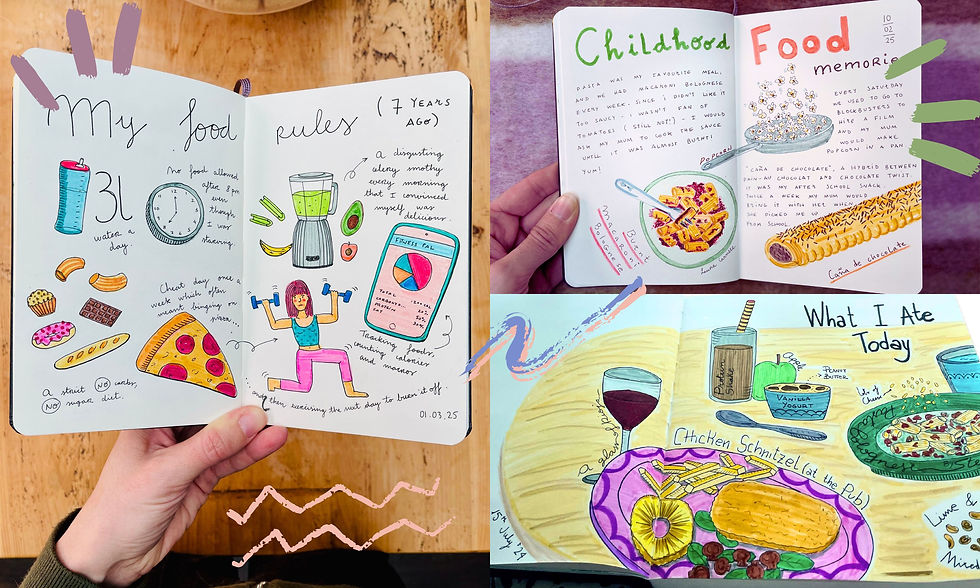The Benefits of Art Journaling for Emotional Eating and Body Image
- Laura

- Jun 2
- 4 min read
Updated: Aug 7
I didn't discover art journaling through food or body image struggles. I found it during grief.
A few weeks after my mom passed away last year, I was in London with a friend when I came across a beautiful, creative journal in a bookstore - Drawing on Grief by Kate Sutton. I felt drawn to it instantly, so I bought it.
The next day, I picked up my markers and opened the first page without knowing what to expect. I discovered how Kate's mindful prompts were guiding me through colours, shapes, and textures, gently helping me explore my feelings around loss and grief.
I never expected that little keepsake would be the start of a new kind of healing. It helped me open up and express what I couldn't say out loud. It encouraged me to dig into the past, to reflect on my relationship with my mum. As I kept drawing and journaling, other things showed up: blocked childhood memories, buried from the pain. Unresolved traumas that were too old but still raw.
So I kept drawing. And somehow, that gave me space to notice, feel, forgive, and heal.

From Grief to Body Image and Food Struggles
This creative journey through grief slowly opened the door to something else I had pushed aside for years: my relationship with food and my body.
I realised that I had never really journaled, let alone talked to anybody about it. I never fully allowed myself to understand my eating habits, the way I behaved around food. I never acknowledged the guilt I felt when I ate foods from my ''forbidden'' list, the anxiety that came with all the rules I'd set around food, the self-punishment when I didn't meet my macros, the negative talk around my body.
But I knew the moment I picked up my pens and started to draw and write about it, all of that would come up. And it did.

What Is Art Journaling?
Art journaling is a form of expressive writing and drawing that combines visual elements with words. It is a modern, creative approach to healing, a private, safe space where you can explore your thoughts, emotions and experiences without judgment.
Art journaling draws on the proven benefits of expressive writing and art-making, both well-supported by research.
Journaling has proven to have mental health benefits, including reducing anxiety, stress, increasing awareness and regulating emotions.
Visual art-making has been found to lower cortisol (the stress hormone), improve mood, and support self-regulation, even in people with no artistic experience. (1)
Art journaling lets you express what you feel without needing the perfect words. It gives shape to things that often stay stuck inside, and that alone can bring relief, insight, and healing.
The benefits of art journaling for emotional eating and body image
After using art journaling for grief, I started applying the same creative process to my struggles with food and body image. There are several ways art journaling can help with food and body healing, but here are my top 5 from what I’ve learned:
It helps you connect with your emotions instead of avoiding them.
For some people, and I include myself here, expressing their emotions can be hard. During my childhood, I was told not to cry or talk about my feelings because it was seen as a sign of weakness. So for many years, I turned to food to numb or distract from difficult feelings. Art journaling not only helps you connect with your emotions but also helps you express yourself without using the perfect words. When you scribble, paint, or write without pressure, you start to notice what’s underneath the urge to eat or restrict. Naming and expressing these feelings visually helps reduce the emotional load.
It creates distance from your inner critic.
When thoughts like “I’m fat,” “I’m ugly,” or “I ate like a pig!” pop up, it’s easy to absorb them as truth and feel completely overwhelmed. But when you put those thoughts on paper—through shapes, colours, or words—you create a bit of distance between you and that inner critic. Seeing them outside your head, just floating on the page, helps you realise: they’re not facts.

It encourages self-compassion
In a society that praises thin, tall, flawless bodies, it’s easy to speak harshly to ourselves. But art journaling can shift the way we see and treat ourselves. Gentle prompts like “What would I tell myself if I were speaking to a friend?” or “What do I wish someone had told me about my body?” invite self-compassion, softness, curiosity, and care; qualities we need for real healing.
It helps uncover hidden beliefs and patterns
We often carry old food rules and body beliefs we never questioned, i.e “I must always eat clean,” “Thin equals healthy,” “I’m only lovable if I’m in control.” Art journaling helps bring these to the surface. Once they’re visible, you can start to challenge and shift them. This process mirrors what’s known in therapy as cognitive restructuring, and creative journaling makes it more intuitive.
It supports nervous system regulation
The act of doodling, colouring, drawing repetitive lines, or creating shapes can be soothing for the nervous system, especially when you're feeling anxious around food or triggered by body image. (2)
Art journaling can cultivate self-esteem and self-awareness, promote emotional resiliency, and personal insight.
I can hear you saying: But I’m Not Creative…
That’s the most common thing people say when I mention art journaling, and I get it. We’ve been taught to think creativity is about being good at drawing or having some kind of artistic talent. But that’s not the point of art journaling.
You’re not trying to make something beautiful. You’re creating space to feel, notice, and express. That might look like stick figures, messy scribbles, or a page filled with angry red circles. There’s no wrong way to do it.
Want to Try It for Yourself?
If you want to explore the benefits of art journaling for emotional eating and body image, I share guided prompts and ideas on Patreon. And if you’re in the Southampton area, you’re welcome to join my next workshop!


Comments